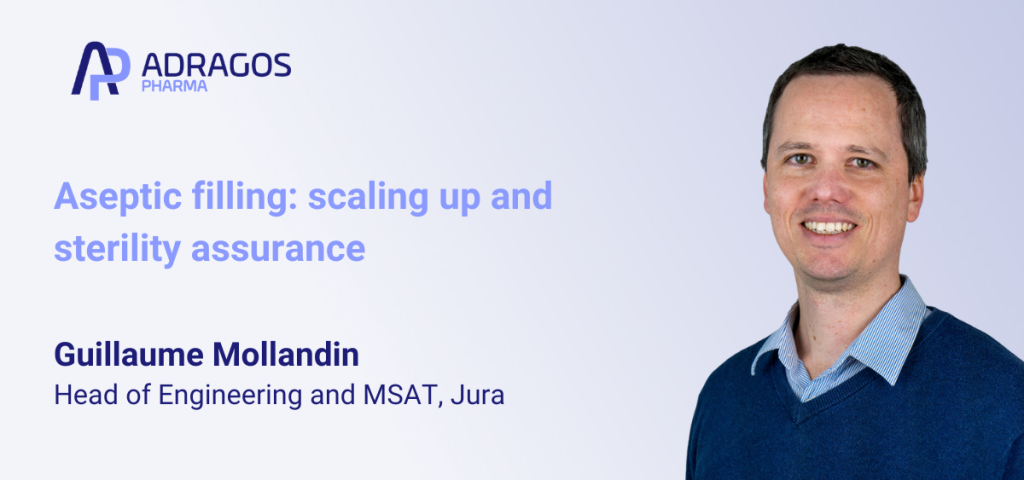Patients rely on pharmaceutical manufacturers to ensure that the medicines they are given are safe. For injectable products, aseptic filling is key, and facilities such as Adragos Jura must follow regulatory guidelines extremely carefully.
The product must be totally protected against the environment, with the filling line within a cleanroom that is over pressured to prevent ingress of air from outside. And there are also physical barriers between the operator and the product so we can be sure there is absolutely no risk of contact. Human operators represent the largest risk to sterility!
Here in Jura, we can fill both lyophilised products and liquids. With lyophilised products, scale-up is a particular challenge. First, the freeze drying process is developed on a small scale, before scaling up to the larger batch sizes appropriate for clinical supplies. Ultimately, it will need further scaling to meet commercial demand.
The initial development will use a very small freeze dryer, and produce sufficient material to fill just a handful of vials. We can then move into our clinical phase freeze dryer, which has a capacity of 3m2. If the product makes it to the market and commercial production is required, our largest freeze dryers have a capacity of about 10m2.
While this sequential scale-up sounds fairly straightforward, in reality, it’s not so simple. As the scale increases, we need to check that all the critical process parameters remain under control. Yet the scale-up introduces a number of process risk factors. There might be variability in the mass transfer, for example, or Edges effect, triggering non uniform temperature. As soon as you change the volume, the recipe must be adapted to ensure repeatability. Knowledge about how the different freeze dryers behave in the real world is essential.
A liquid fill is generally a little more straightforward to scale up. Here, the key factor is extreme precision in the fill volume. Selecting the optimal pump type to match the product’s properties is also important. Would a peristaltic pump be suitable, or might a rotary piston pump be more appropriate? The choice will partly depend on the product’s density and viscosity, but also the fill volumes required, and other product caracteristics like resistance to shear stress.
The choice of pump is product related, not format related – it will be the same regardless of whether a vial or a prefilled syringe (PFS) is being used. With a PFS, there is the additional layer of complexity – and therefore risk – because the position of the stopper on the plunger and the product is critical. The precision of the fill volume has to be exceptionally high to ensure the dosage is exact and for some specific product, no air bubbles between the product and the stopper.
Equipment design & validation
Before we begin any production run, whether it is for clinical or commercial purposes, we will spend a significant amount of time designing and validating the process and the equipment. Validation includes specific runs to test the line for stability, and we will also carry out aseptic process simulation. This is a validation run prior to production where we simulate all the production steps, including the aseptic filling, using a culture medium rather than the product itself.
The filled vials are then incubated in a hot chamber 22.5º for 7 days and then 32.5º for other 7 days, and then they are evaluated carefully to check the medium remains microbe-free. We use a medium that is ideally suited to microbial growth, encouraging any microbes that might be present to multiply. If there are no microbes evident in the vials or PFSs after the incubation, we can be sure the sterility of the process is being maintained throughout.
These test runs are a regulatory requirement. Three separate runs have to pass sterility testing before production can begin, and a further simulation run must be carried out every six months to ensure it still meets sterility standards. With the new Annex 1 guidelines in Europe, we can no longer assume that if a filling process gives sterile products at the start it will remain effective forever.
This is also the case for all the critical assets used in production: they need to be requalified on a regular basis – the cleanroom, all the equipment and services, and all the controls will need to be recalibrated. All this must be done at a frequency that meets the demands of the risk assessment.
The team at Jura has developed a specific process for operational readiness. We created workstreams within the organisation, including a matrix approach that includes all the different stakeholders and departments. As well as engineering/MSAT, this includes technical services, the QA and QC departments, manufacturing, and so on. We work well together, and this makes for a much more seamless tech transfer operation. Being a small site where everyone knows each other helps a great deal!
In the engineering department, it is important that we do not work as a siloed unit. Tech transfer is so much quicker, easier and more successful when all the different teams work closely together.

